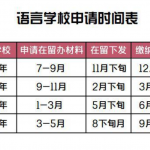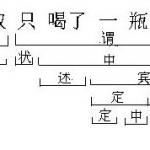胡壮麟语言学教程大纲分析及试题(2)
本站小编 免费考研网/2019-03-17
12. Fore as in foretell is both a prefix and a bound morpheme.
13. Base refers to the part of the word that remains when all inflectional affixes are removed.
14. In most cases, prefixes change the meaning of the base whereas suffixes change the word-class of the base.
15. Conversion from noun to verb is the most productive process of a word.
16. Reduplicative compound is formed by repeating the same morpheme of a word.
17. The words whimper, whisper and whistle are formed in the way of onomatopoeia.
18. In most cases, the number of syllables of a word corresponds to the number of morphemes.
19. Back-formation is a productive way of word-formations.
20. Inflection is a particular way of word-formations.
III. Fill in the blanks. (20%)
21. An __________ is pronounced letter by letter, while an __________ is pronounced as a word.
22. Lexicon, in most cases, is synonymous with __________.
23. Orthographically, compounds are written in three ways: __________, __________ and __________.
24. All words may be said to contain a root __________.
25. A small set of conjunctions, prepositions and pronouns belong to __________ class, while the largest part of nouns, verbs, adjectives and adverbs belongs to __________ class.
26. __________ is a reverse process of derivation, and therefore is a process of shortening.
27. __________ is extremely productive, because English had lost most of its inflectional endings by the end of Middle English period, which facilitated the use of words interchangeably as verbs or nouns, verbs or adjectives, and vice versa.
28. Words are divided into simple, compound and derived words on the __________ level.
29. A word formed by derivation is called a __________, and a word formed by compounding is called a __________.
30. Bound morphemes are classified into two types: __________ and __________.
IV. Explain the following terms, using examples. (20%)
31. Blending
32. Allomorph
33. Closed-class word
34. Morphological rule
V. Answer the following questions. (20%)
35. How many types of morphemes are there in the English language? What are they? (厦门大学,2003)
36. What are the main features of the English compounds?
VI. Analyze the following situation. (20%)
37. Match the terms under COLUMN I with the underlined forms from COLUMN II (武汉大学,2004)
I II
(1) acronym a. foe
(2) free morpheme b. subconscious
(3) derivational morpheme c. UNESCO
(4) inflectional morpheme d. overwhelmed
(5) prefix e. calculation
Test Four: Syntax
I. Choose the best answer. (20%)
1. The sentence structure is ________.
A. only linear B. only hierarchical
C. complex D. both linear and hierarchical
2. The syntactic rules of any language are ____ in number.
A. large B. small C. finite D. infinite
3. The ________ rules are the rules that group words and phrases to form grammatical sentences.
A. lexical B. morphological C. linguistic D. combinational
4. A sentence is considered ____ when it does not conform to the grammatical knowledge in the mind of native speakers.
A. right B. wrong C. grammatical D. ungrammatical
5. A __________ in the embedded clause refers to the introductory word that introduces the embedded clause.
A. coordinator B. particle C. preposition D. subordinator
6. Phrase structure rules have ____ properties.
A. recursive B. grammatical C. social D. functional
7. Phrase structure rules allow us to better understand _____________.
A. how words and phrases form sentences.
B. what constitutes the grammaticality of strings of words
C. how people produce and recognize possible sentences
D. all of the above.
8. The head of the phrase “the city Rome” is __________.
A. the city B. Rome C. city D. the city Rome
9. The phrase “on the shelf” belongs to __________ construction.
A. endocentric B. exocentric C. subordinate D. coordinate
10. The sentence “They were wanted to remain quiet and not to expose themselves.” is a __________ sentence.
A. simple B. coordinate C. compound D. complex
II. Decide whether the following statements are true or false. (10%)
11. Universally found in the grammars of all human languages, syntactic rules that comprise the system of internalized linguistic knowledge of a language speaker are known as linguistic competence.
12. The syntactic rules of any language are finite in number, but there is no limit to the number of sentences native speakers of that language are able to produce and comprehend.
13. In a complex sentence, the two clauses hold unequal status, one subordinating the other.
14. Constituents that can be substituted for one another without loss of grammaticality belong to the same syntactic category.
15. Minor lexical categories are open because these categories are not fixed and new members are allowed for.
16. In English syntactic analysis, four phrasal categories are commonly recognized and discussed, namely, noun phrase, verb phrase, infinitive phrase, and auxiliary phrase.
17. In English the subject usually precedes the verb and the direct object usually follows the verb.
18. What is actually internalized in the mind of a native speaker is a complete list of words and phrases rather than grammatical knowledge.
19. A noun phrase must contain a noun, but other elements are optional.
20. It is believed that phrase structure rules, with the insertion of the lexicon, generate sentences at the level of D-structure.
III. Fill in the blanks. (20%)
21. A __________ sentence consists of a single clause which contains a subject and a predicate and stands alone as its own sentence.
22. A __________ is a structurally independent unit that usually comprises a number of words to form a complete statement, question or command.
23. A __________ may be a noun or a noun phrase in a sentence that usually precedes the predicate.
24. The part of a sentence which comprises a finite verb or a verb phrase and which says something about the subject is grammatically called __________.
25. A __________ sentence contains two, or more, clauses, one of which is incorporated into the other.
26. In the complex sentence, the incorporated or subordinate clause is normally called an __________ clause.
27. Major lexical categories are __________ categories in the sense that new words are constantly added.
28. __________ condition on case assignment states that a case assignor and a case recipient should stay adjacent to each other.
29. __________ are syntactic options of UG that allow general principles to operate in one way or another and contribute to significant linguistic variations between and among natural languages.
30. The theory of __________ condition explains the fact that noun phrases appear only in subject and object positions.
IV. Explain the following terms, using examples. (20%)
31. Syntax
32. IC analysis
33. Hierarchical structure
34. Trace theory
V. Answer the following questions. (20%)
35. What are endocentric construction and exocentric construction? (武汉大学,2004)
36. Distinguish the two possible meanings of “more beautiful flowers” by means of IC analysis. (北京第二外国语大学,2004)
VI. Analyze the following situation. (20%)
37. Draw a tree diagram according to the PS rules to show the deep structure of the sentence:
The student wrote a letter yesterday.
Test Five: Semantics
[Mainly taken from lxm1000w’s exercises. – icywarmtea]
I. Choose the best answer. (20%)
1. The naming theory is advanced by ________.
A. Plato B. Bloomfield C. Geoffrey Leech D. Firth
2. “We shall know a word by the company it keeps.” This statement represents _______.
A. the conceptualist view B. contexutalism
C. the naming theory D. behaviorism
3. Which of the following is NOT true?
A. Sense is concerned with the inherent meaning of the linguistic form.
B. Sense is the collection of all the features of the linguistic form.
C. Sense is abstract and decontextualized.
D. Sense is the aspect of meaning dictionary compilers are not interested in.
4. “Can I borrow your bike?”_______ “You have a bike.”
A. is synonymous with B. is inconsistent with
C. entails D. presupposes
5. ___________ is a way in which the meaning of a word can be dissected into meaning components, called semantic features.
A. Predication analysis B. Componential analysis
C. Phonemic analysis D. Grammatical analysis
6. “Alive” and “dead” are ______________.
A. gradable antonyms B. relational antonyms
C. complementary antonyms D. None of the above
7. _________ deals with the relationship between the linguistic element and the non-linguistic world of experience.
A. Reference B. Concept C. Semantics D. Sense
8. ___________ refers to the phenomenon that words having different meanings have the same form.
A. Polysemy B. Synonymy C. Homonymy D. Hyponymy
9. Words that are close in meaning are called ______________.
A. homonyms B. polysemies C. hyponyms D. synonyms
10. The grammaticality of a sentence is governed by _______.
A. grammatical rules B. selectional restrictions
C. semantic rules D. semantic features
II. Decide whether the following statements are true or false. (10%)
11. Dialectal synonyms can often be found in different regional dialects such as British English and American English but cannot be found within the variety itself, for example, within British English or American English.
12. Sense is concerned with the relationship between the linguistic element and the non-linguistic world of experience, while the reference deals with the inherent meaning of the linguistic form.
13. Linguistic forms having the same sense may have different references in different situations.
14. In semantics, meaning of language is considered as the intrinsic and inherent relation to the physical world of experience.
15. Contextualism is based on the presumption that one can derive meaning from or reduce meaning to observable contexts.
16. Behaviorists attempted to define the meaning of a language form as the situation in which the speaker utters it and the response it calls forth in the hearer.
17. The meaning of a sentence is the sum total of the meanings of all its components.
18. Most languages have sets of lexical items similar in meaning but ranked differently according to their degree of formality.
19. “It is hot.” is a no-place predication because it contains no argument.
20. In grammatical analysis, the sentence is taken to be the basic unit, but in semantic analysis of a sentence, the basic unit is predication, which is the abstraction of the meaning of a sentence.
III. Fill in the blanks. (20%)
21. __________ can be defined as the study of meaning.
22. The conceptualist view holds that there is no __________ link between a linguistic form and what it refers to.
23. __________ means what a linguistic form refers to in the real, physical world; it deals with the relationship between the linguistic element and the non-linguistic world of experience.
24. Words that are close in meaning are called __________.
25. When two words are identical in sound, but different in spelling and meaning, they are called __________.
26. __________ opposites are pairs of words that exhibit the reversal of a relationship between the two items.
27. __________ analysis is based upon the belief that the meaning of a word can be divided into meaning components.
28. Whether a sentence is semantically meaningful is governed by rules called __________ restrictions, which are constraints on what lexical items can go with what others.
29. A(n) __________ is a logical participant in a predication, largely identical with the nominal element(s) in a sentence.
30. According to the __________ theory of meaning, the words in a language are taken to be labels of the objects they stand for.
IV. Explain the following terms, using examples. (20%)
31. Entailment
32. Proposition
33. Componential analysis
34. Reference
V. Answer the following questions. (20%)
35. What are the sense relations between the following groups of words?
Dogs, cats, pets, parrots; trunk, branches, tree, roots (青岛海洋大学,1999)
相关话题/语言学
语言学纲要学习指导书练习答案(整理版)
《语言学概论》学习辅导书参考答案(导言) 一、名词解释(20分,每小题4分) 1.语言学:就是以语言为研究对象的科学,研究语言的本质、语言的结构和发展规律。 2.小学:指我国传统的语文学,包括文字学、音韵学、训诂学三方面的内容。 3.专语语言学:也叫具体语言学、个别语言学,以一种(或几种有联系的)语言 ...专业课考研资料 本站小编 免费考研网 2019-02-13华师语言所学硕2019年语言学概论考研真题
一、填空题所谓递归性,是指相同的结构规则可以( ),可以由( )扩展成层层嵌套的( )。语言系统可以分为( )、( )、( )等子系统。黏着语又称( ),其特点是通过附加多种( )来表示各种( )。音质的不同取决于三方面的条件:一是( ),二是( ),三是( )的形状。根据义项之间不同的关 ...专业课考研资料 本站小编 免费考研网 2019-01-03丁言仁《英语语言学纲要》笔记和课后习题详解
目录封面内容简介目录第1章 我们身边的语言 1.1 复习笔记 1.2 课后习题详解第2章 英语语法 2.1 复习笔记 2.2 课后习题详解第3章 英语语音系统和书写系统 3.1 复习笔记 3.2 课后习题详解第4章 英语语义和词汇 4.1 复习笔记 4.2 课后习题详解第5章 语言在语境中的应用 5 ...辅导考试考研资料 本站小编 免费考研网 2018-11-30扬州大学文学院816语言学理论历年考研真题汇编
目录封面内容简介目录2014年扬州大学文学院816语言学理论考研真题2015年扬州大学文学院816语言学理论考研真题2016年扬州大学文学院816语言学理论考研真题2017年扬州大学文学院816语言学理论考研真题2018年扬州大学文学院816语言学理论考研真题内容简介本书收录了扬州大学文学院&ldq ...辅导考试考研资料 本站小编 免费考研网 2018-11-30江西师范大学文学院语言学概论历年考研真题汇编
目录封面内容简介目录2012年江西师范大学文学院语言学概论考研真题2013年江西师范大学文学院语言学概论考研真题2014年江西师范大学文学院语言学概论考研真题2015年江西师范大学文学院语言学概论考研真题2016年江西师范大学文学院语言学概论考研真题2017年江西师范大学文学院语言学概论考研真题内容 ...辅导考试考研资料 本站小编 免费考研网 2018-11-30日本语言学校介绍及之后的升学之路
 随着大量留学生涌入日本,日本的语言学校可以说是遍地开花。很多学生和家长对语言学校始终保持疑虑,担心在日本读语言学校对学生升学帮助不大还浪费时间,今天小编就系统的介绍一下日本的语言学校及语言学校毕业后如何申请修士。 语言学校的作用: 1. 学日语: 顾名思义,语言学校是学日语的地方,如果日语不 ...日本留学 本站小编 免费考研网 2018-11-18
随着大量留学生涌入日本,日本的语言学校可以说是遍地开花。很多学生和家长对语言学校始终保持疑虑,担心在日本读语言学校对学生升学帮助不大还浪费时间,今天小编就系统的介绍一下日本的语言学校及语言学校毕业后如何申请修士。 语言学校的作用: 1. 学日语: 顾名思义,语言学校是学日语的地方,如果日语不 ...日本留学 本站小编 免费考研网 2018-11-182019年北京邮电大学817英语语言学与文学基础考研大纲
817英语语言学与文学基础一、考试要求要求考生系统地掌握大学本科期间所学的语言学概论和英美文学的基本概念和知识,并且语言学方向考生能够运用语言学基本规则和理论分析一般的语言现象,文学方向考生能够运用所学知识对作家、作品和文学人物进行初步的分析、批判。二、考试内容语言的概念、特征以及各分支的概念、研究 ...专业课大纲 本站小编 免费考研网 2018-11-042019年浙江财经大学语言学概论和现代汉语考研初试大纲
《语言学概论和现代汉语》考试大纲一、考试目的和要求本课程涵盖汉语言文学专业本科阶段现代汉语和语言学概论的主要内容,是汉语言文学专业的核心课程,也是汉语言文字学专业学生必须掌握的基础性课程。考试目的:测试学生运用语言理论分析和解决语言问题的基本能 ...专业课大纲 本站小编 免费考研网 2018-11-042019年浙江财经大学语言学理论考研初试大纲
《语言学理论》考试大纲一、考试目的和要求本课程涵盖汉语言文学专业本科阶段语言学概论的主要内容,是汉语言文学专业的核心课程,也是汉语言文字学专业学生必须掌握的基础性课程。考试目的:测试学生运用语言理论分析和解决语言问题的基本能力,并由此判断学生是否具有进一步深造的基本素质和 ...专业课大纲 本站小编 免费考研网 2018-11-042019年华侨大学810语言学概论考研初试大纲
2019年华侨大学硕士研究生招生考试初试自命题科目考试大纲招生学院: 华文学院 招生专业: 华语与华文教育科目名称: 语言学概论一、考试形式与试卷结构(一)试卷满分值及考试时间本试卷满分为150分,考试时间为180分钟。(二)答题方式答题方式为闭卷、笔试。试卷由试题和答题纸组成;答案必须写在答题纸( ...专业课大纲 本站小编 免费考研网 2018-11-042019年广东外语外贸大学050102语言学及应用语言学考研专业目录
据广东外语外贸大学研究生院消息,2019年广东外语外贸大学050102语言学及应用语言学考研专业目录已经公布,详情如下: ...专业目录 本站小编 免费考研网 2018-11-042019年广东外语外贸大学050211外国语言学及应用语言学考研专业目录
据广东外语外贸大学研究生院消息,2019年广东外语外贸大学050211外国语言学及应用语言学考研专业目录已经公布,详情如下: ...专业目录 本站小编 免费考研网 2018-11-04山东师范大学外国语学院818英语语言学及应用语言学基础(含英语语言学、应用语言学与英语教学基础知识)历年考研真题及详解
目录封面内容简介目录2017年山东师范大学818英语语言学及应用语言学基础考研真题及详解2018年山东师范大学818英语语言学及应用语言学基础考研真题及详解内容简介本书收集了山东师范大学外国语学院英语语言学及应用语言学基础(含英语语言学、应用语言学与英语教学基础知识)20 ...辅导考试考研资料 本站小编 免费考研网 2018-11-02南开大学2010年语言学概论考研真题
 2010年语言学概论真题答案 一.举例并解释 1.孤立语(知识点:书P112) 根据词的结构划分出来的一种语言类型,也叫词根语,指没有构形语素或基本无构形语素的语言。词不发生语法形式变化,语序和虚词成为基本的语法形式。如:汉语、越南语。 2.音位变体(知识点:书P71) 音位变体是属于一个音位的各 ...专业课考研资料 本站小编 免费考研网 2018-08-26
2010年语言学概论真题答案 一.举例并解释 1.孤立语(知识点:书P112) 根据词的结构划分出来的一种语言类型,也叫词根语,指没有构形语素或基本无构形语素的语言。词不发生语法形式变化,语序和虚词成为基本的语法形式。如:汉语、越南语。 2.音位变体(知识点:书P71) 音位变体是属于一个音位的各 ...专业课考研资料 本站小编 免费考研网 2018-08-26日本语言学校怎么样?日本语言学校考察实录
 启程 2017年5月9日,在北京首都国际机场跟男神博士见面,马上就要启程,真是心潮澎湃,愉悦的因子在身边跳跃。同博士在机场换了部分日币,就匆匆赶往登机处,开启了日本学校探访之行 抵达 下午2点到达日本成田国际机场,刚下飞机,就收到热心的双叶外国语老师的信息,已然在出口等待我们,当然同行的还有其他的老师。 ...日本留学 本站小编 免费考研网 2018-08-24
启程 2017年5月9日,在北京首都国际机场跟男神博士见面,马上就要启程,真是心潮澎湃,愉悦的因子在身边跳跃。同博士在机场换了部分日币,就匆匆赶往登机处,开启了日本学校探访之行 抵达 下午2点到达日本成田国际机场,刚下飞机,就收到热心的双叶外国语老师的信息,已然在出口等待我们,当然同行的还有其他的老师。 ...日本留学 本站小编 免费考研网 2018-08-24


